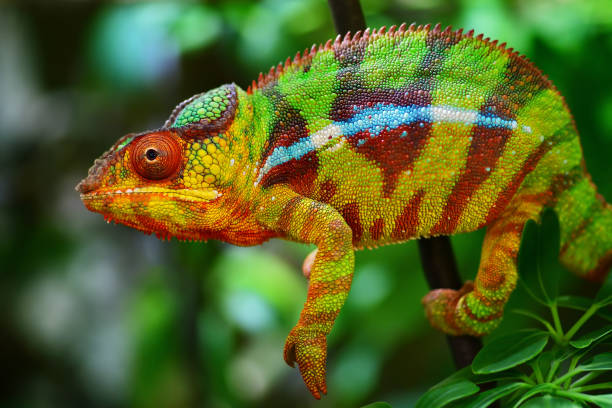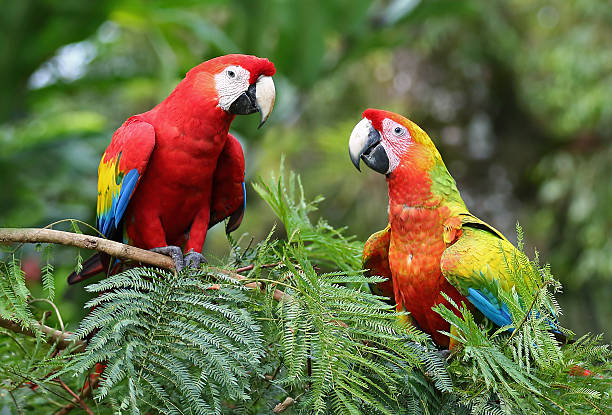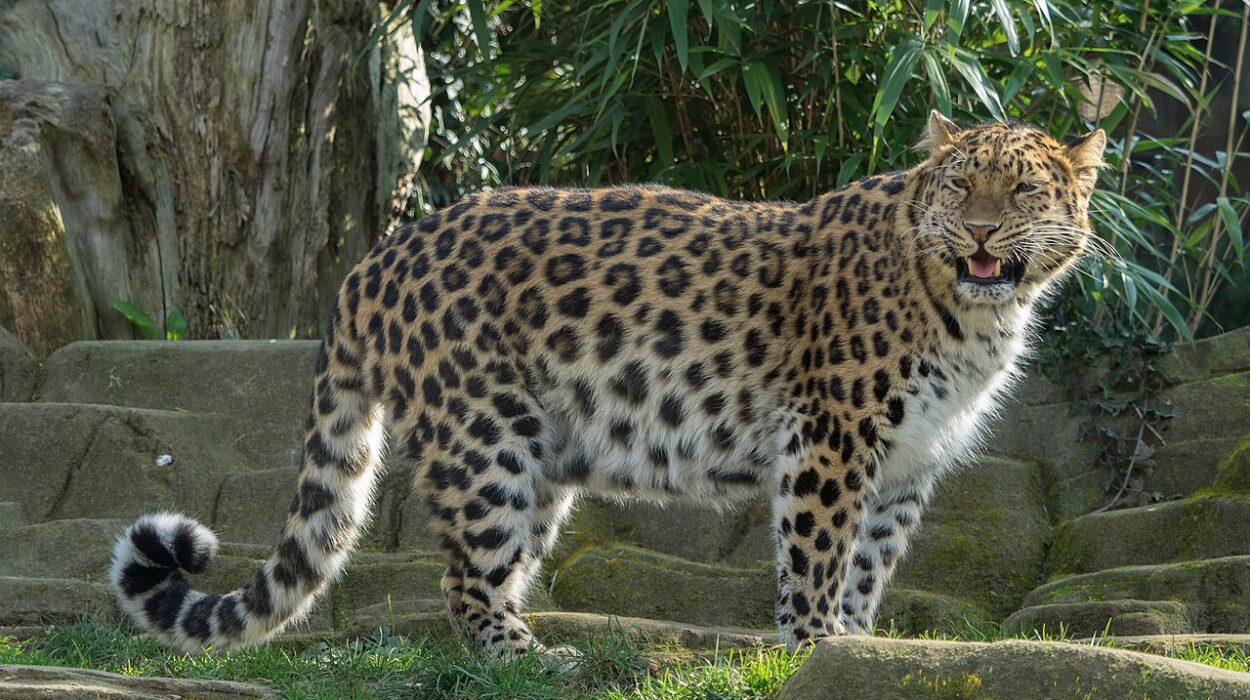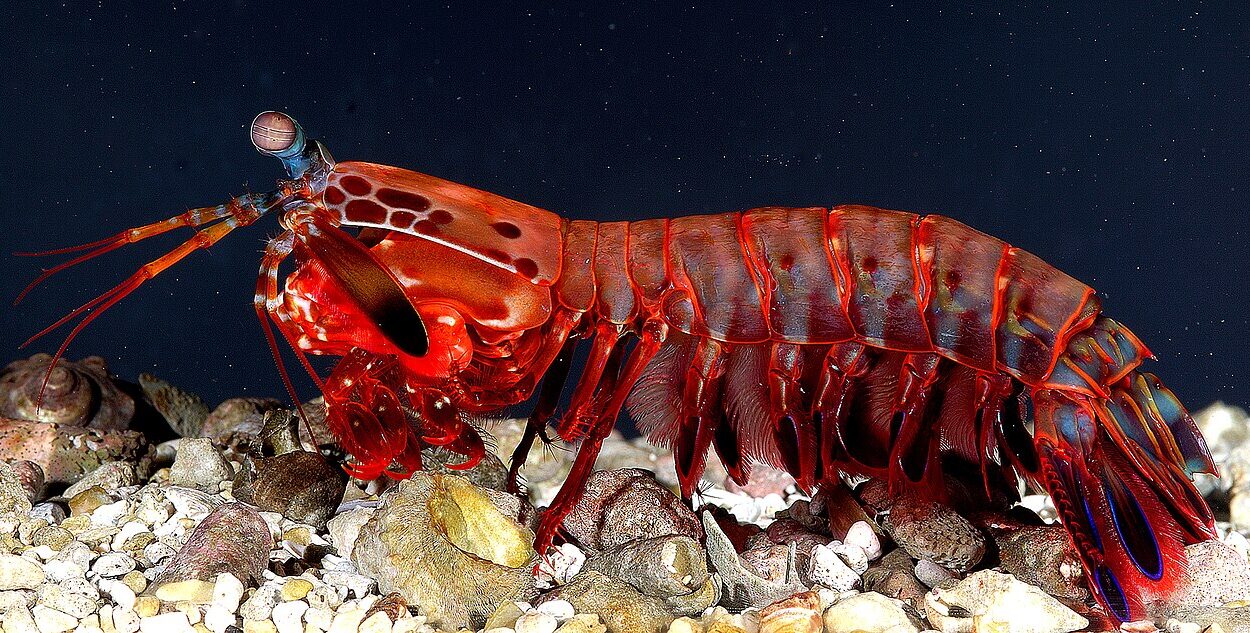Among the countless wonders of the natural world, few are as mesmerizing as creatures that can change color. Imagine a living being whose skin shifts from deep emerald to fiery crimson, or from sandy beige to midnight black — not through magic, but through biology. In the world of reptiles, this ability is both art and survival, a language written in pigment and light.
Color-changing reptiles are nature’s living canvases. They can alter their hues to blend into their surroundings, regulate temperature, express emotion, or communicate with rivals and mates. This transformation is not random — it is the precise work of specialized skin cells, light-reflecting structures, and complex neural control.
Let us step into their world — a realm where skin becomes a story, and color is both shield and signal. These twelve remarkable reptiles are among the planet’s finest color-shifting artists, each revealing a different side of nature’s brilliance.
1. Panther Chameleon – The Master of the Rainbow
If color change were an art form, the Panther Chameleon (Furcifer pardalis) would be Picasso. Found in the lush forests of Madagascar, this reptile can transform into a living kaleidoscope, displaying shades of turquoise, orange, red, green, and blue in dazzling sequences.
But the chameleon’s magic isn’t just about hiding. Male Panther Chameleons use their colors to communicate emotion and dominance. During territorial disputes or courtship, their skin ignites with vibrant intensity — a spectacle of fiery reds and electric blues that can shift within seconds.
Beneath their scaly surface lies the secret: layers of specialized cells called chromatophores and iridophores. The chromatophores contain pigments like red and yellow, while the iridophores reflect and scatter light using tiny nanocrystals. By altering the spacing of these crystals, chameleons manipulate how light interacts with their skin — creating an entire spectrum of colors.
Their ability to switch tones isn’t random but deliberate, directed by their nervous system. It’s both communication and camouflage, survival and seduction — a masterpiece of biological engineering.
2. Green Anole – The American Chameleon
Meet the Green Anole (Anolis carolinensis), often called the “American Chameleon,” though it isn’t one. This small lizard from the southeastern United States can shift between bright green and earthy brown, blending into foliage or bark as needed.
The color change in anoles is more subtle than that of true chameleons, yet it serves powerful purposes. When relaxed or basking in sunlight, they shine a vivid green. When threatened, cold, or stressed, they darken to brown or gray.
The transformation occurs through melanophores, pigment cells containing melanin. By dispersing or concentrating this pigment, the lizard controls how much light reflects off its skin.
Color also communicates emotion: a dominant male showing off his dewlap — a bright red throat fan — often glows emerald green, while a submissive one fades to brown. The Green Anole’s palette may be limited, but its elegance lies in simplicity — a living leaf, always in conversation with its environment.
3. Desert Collared Lizard – The Warrior of the Sands
In the sun-scorched deserts of North America, the Desert Collared Lizard (Crotaphytus collaris) reigns as both predator and performer. Its bold black “collar” bands give it its name, but its true beauty lies in its ability to shift colors with the rhythm of the day.
During cool mornings, these lizards appear pale or grayish, helping them absorb warmth. As the day grows hotter, they brighten into shades of yellow, turquoise, or orange to reflect heat and stay cool. Males often display more vivid colors during mating season — a striking signal of vitality to potential mates.
The color transformation here is physiological rather than emotional. It’s controlled by the expansion and contraction of pigment cells responding to temperature and light levels.
In the desert, where survival depends on mastering heat, color is a weapon as much as camouflage. The Desert Collared Lizard’s shifting hues tell the story of adaptation written in sunlight.
4. Fiji Banded Iguana – The Emerald Jewel of the Pacific
The Fiji Banded Iguana (Brachylophus fasciatus) looks like it was painted by an artist who fell in love with the tropics. Its vibrant green body is streaked with turquoise bands, which can fade, brighten, or shift depending on mood, temperature, and social cues.
Found only on the Fiji Islands, this reptile is a living gem — one that uses its colors to communicate rather than conceal. Males become more intensely colored during breeding season, especially when courting females or defending territory. When threatened, their skin darkens dramatically, a visual warning to rivals.
Color change in Fiji Banded Iguanas is driven by chromatophores arranged in layers, each reflecting different wavelengths of light. Hormones and nerves regulate these cells, allowing fine control over color expression.
These iguanas embody a balance of beauty and biology — proof that nature never creates art without purpose.
5. Jackson’s Chameleon – The Triceratops of the Trees
With its three majestic horns and calm demeanor, the Jackson’s Chameleon (Trioceros jacksonii) seems like a miniature dinosaur. Native to East Africa but popular worldwide as a pet, it’s also a skilled color-shifter, capable of displaying deep greens, bright yellows, and vivid blues.
Jackson’s Chameleons use their color change primarily for communication. Males light up in brighter hues when challenging rivals or impressing females. When calm or basking, they display tranquil greens; when stressed or ill, they may turn dark brown or black.
Like other chameleons, their color control comes from nanocrystals within iridophore cells that reflect light in complex ways. This structural coloration is more sophisticated than pigment alone — it’s physics and biology dancing together.
In the misty forests of Kenya and Tanzania, these chameleons move slowly but speak vividly — each color shift a silent message in the language of light.
6. Mediterranean Gecko – The Nighttime Shapeshifter
The Mediterranean Gecko (Hemidactylus turcicus) is a master of nocturnal camouflage. By day, it’s pale, blending seamlessly with limestone walls or tree bark. By night, it darkens to absorb heat and vanish into shadows.
Unlike chameleons, its color change is primarily adaptive rather than communicative. Its ability helps it regulate temperature and avoid predators under changing light conditions.
The mechanism involves melanin-containing cells that react to both light and temperature. When light levels drop, the pigment spreads, darkening the skin. When exposed to brightness, it contracts, turning the gecko pale again.
Though modest in its palette, the Mediterranean Gecko’s transformation is practical perfection — a cloak of invisibility in the ancient Mediterranean nights where survival often depends on silence and subtlety.
7. Common Chuckwalla – The Desert Transformer
In the barren deserts of the American Southwest lives the Chuckwalla (Sauromalus ater), a stocky herbivorous lizard that uses color as both armor and mirror.
These lizards change color based on temperature and mood. In cool mornings, they appear dark gray or brown to absorb sunlight. As the heat intensifies, they turn pale, almost sandy, to reflect the sun’s rays and stay cool.
Males often exhibit bright orange or reddish hues during the breeding season, signaling strength and vitality. Their transformation is hormonally and thermally regulated, allowing them to thrive in one of the harshest environments on Earth.
The Chuckwalla’s changing skin tells a story of endurance — a silent adaptation to a landscape where the sun rules all.
8. Veiled Chameleon – The Sculptor of Light
The Veiled Chameleon (Chamaeleo calyptratus) is perhaps the most recognizable of all color-changing reptiles. With its tall casque (helmet-like crest) and serene gaze, it seems both alien and elegant.
Native to Yemen and Saudi Arabia, the Veiled Chameleon uses its color change for everything from camouflage to courtship. A calm chameleon glows in soft greens and yellows, while an excited or aggressive one can flash dramatic patterns of orange, blue, and even white.
The process is a blend of emotional and environmental factors. When basking, it turns dark to absorb heat. When cold, sick, or stressed, its colors dull. When socializing or defending territory, it becomes a living painting of intent.
The secret lies in two layers of iridophores: one reflects visible light for brilliant colors, while the deeper layer reflects infrared light to help regulate body temperature. The Veiled Chameleon is thus not only beautiful but scientifically astonishing — a creature that bends light for both communication and comfort.
9. Brown Anole – The Adaptive Opportunist
Cousin to the Green Anole, the Brown Anole (Anolis sagrei) is another master of environmental blending. Originally from the Caribbean, it has spread across the Americas, thriving in diverse habitats.
This reptile can shift from light gray to deep brown, often with darker patterns or stripes. Unlike the Green Anole, it rarely turns green — its color changes revolve around shades of brown to match bark, soil, or leaf litter.
The transformation is driven by melanin concentration, body temperature, and stress. A frightened anole darkens instantly, while a relaxed one lightens. During territorial displays, males flaunt vivid orange dewlaps against their shifting bodies, creating a striking contrast.
The Brown Anole proves that even limited palettes can tell powerful stories of adaptation and survival.
10. Blue-Tongued Skink – The Hidden Artist
At first glance, the Blue-Tongued Skink (Tiliqua scincoides) seems ordinary — a stout-bodied reptile with smooth scales. But this Australian native hides an unexpected secret: subtle, yet effective, color change.
These skinks can slightly shift their skin tone to regulate temperature or camouflage within their environment. When threatened, they darken to appear larger and more intimidating. Their color adjustments also help them thermoregulate — darker when cold, lighter when hot.
The most dramatic feature, however, is their brilliant cobalt-blue tongue. When cornered, they flash it as a warning display, contrasting sharply with their skin and startling predators.
Though not as flamboyant as chameleons, Blue-Tongued Skinks embody understated brilliance — proving that color, even when subtle, can speak volumes in the language of survival.
11. Namib Desert Gecko – The Phantom of the Dunes
The Namib Desert Gecko (Pachydactylus rangei) is a delicate, almost translucent reptile living in one of Earth’s most extreme environments. It changes color not through vivid pigments, but through transparency and reflection — adapting its pale pink or yellowish tones to the shifting sands.
Its ability to modify skin translucency helps regulate temperature and conceal it from predators in moonlit deserts. When active at night, it appears almost ghostly, reflecting minimal light; by day, it turns slightly opaque to avoid overheating.
This subtle transformation, governed by light-sensitive hormones, is a marvel of micro-adaptation. The Namib Gecko’s survival depends on disappearing — a living whisper in the vast, silent desert.
12. Bearded Dragon – The Social Color Changer
Australia’s beloved Bearded Dragon (Pogona vitticeps) is famous for its friendly demeanor — and its dynamic skin. Unlike most reptiles, it can change color rapidly and in distinct body regions, each serving a unique purpose.
When basking, its back darkens to absorb heat efficiently. When overheated, it lightens to reflect sunlight. During social interactions, the beard — a flap of skin under the chin — can turn jet black in displays of dominance or courtship.
Recent studies have revealed that Bearded Dragons also shift hues to communicate with each other, showing emotional and territorial cues. Their color change is driven by both temperature regulation and social signaling, controlled by hormonal and neural feedback loops.
Their transformation may lack the full spectrum of a chameleon’s, but in its own earthy tones, it conveys a complex narrative — one of intelligence, emotion, and adaptation.
The Science Behind the Color Change
The color-changing ability of reptiles depends on a cellular orchestra hidden beneath their scales. The three primary cell types involved are:
- Melanophores: contain dark melanin pigments.
- Xanthophores and Erythrophores: hold yellow and red pigments.
- Iridophores (or guanophores): reflect light using crystalline structures, producing blues, greens, and iridescent effects.
By expanding or contracting these cells — or rearranging the nanocrystals within them — reptiles can control how light is absorbed and reflected. This process can occur through direct neural control, hormonal influence, or environmental triggers such as light, temperature, or emotion.
It’s not magic — it’s microscopic physics and chemistry perfectly tuned by evolution.
The Many Purposes of a Changing Skin
Why do reptiles change color? The answers are as diverse as the species themselves.
For camouflage, color change helps them hide from predators or ambush prey. For communication, it signals mood, health, and reproductive readiness. For thermoregulation, it manages body temperature by controlling heat absorption and reflection.
In many species, these purposes overlap — a shifting mosaic of survival strategies painted across living skin.
The Emotional Spectrum of Reptiles
Though reptiles are often perceived as cold and instinct-driven, color-changing species reveal emotional depth and behavioral complexity. Stress, excitement, fear, and affection can all trigger visible changes.
When a chameleon brightens with excitement or a bearded dragon darkens its beard in warning, we glimpse the subtle emotional vocabulary of a different kind of consciousness — one that doesn’t speak in words, but in waves of color and light.
The Future of Understanding
Scientists continue to study color-changing reptiles not only for ecological insight but for technological inspiration. The nanostructures in chameleon skin have inspired research into adaptive camouflage, energy-efficient fabrics, and even biomedical sensors that respond to body chemistry.
The same principles that allow a chameleon to shimmer may one day power human innovations in design and engineering.
The Living Art of Adaptation
Every color-changing reptile is a living testament to evolution’s creativity. Their shifting hues blur the line between science and art, between survival and beauty. They remind us that nature doesn’t just exist — it expresses.
From the deserts of Arizona to the forests of Madagascar, from the shining scales of iguanas to the subtle tones of geckos, these twelve reptiles prove that life’s greatest masterpiece is adaptability itself.
When a lizard turns from green to gold or a chameleon ripples with blue fire, it is not simply hiding or heating itself — it is painting with the light of the Earth, one color at a time.






